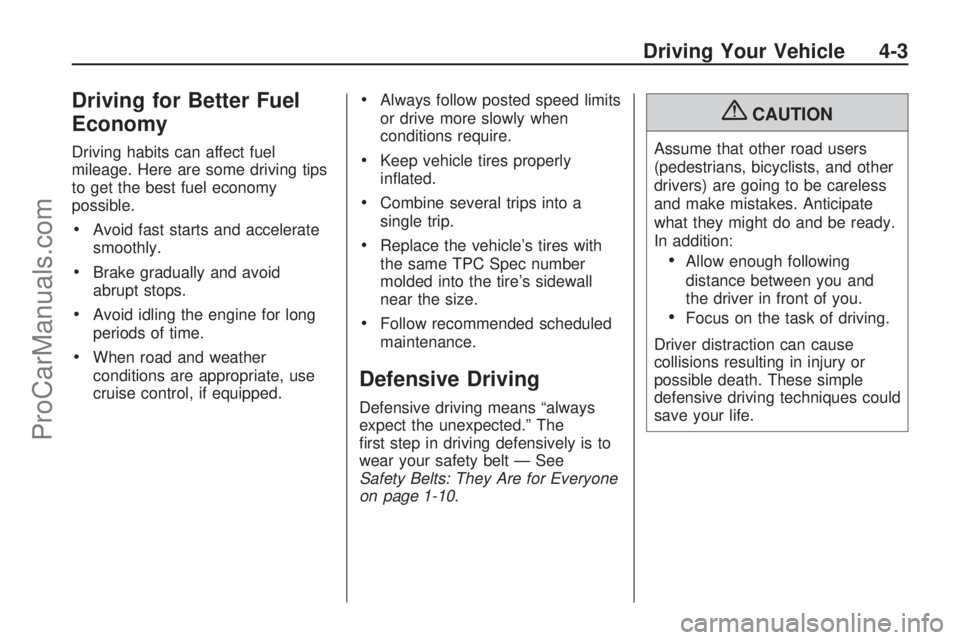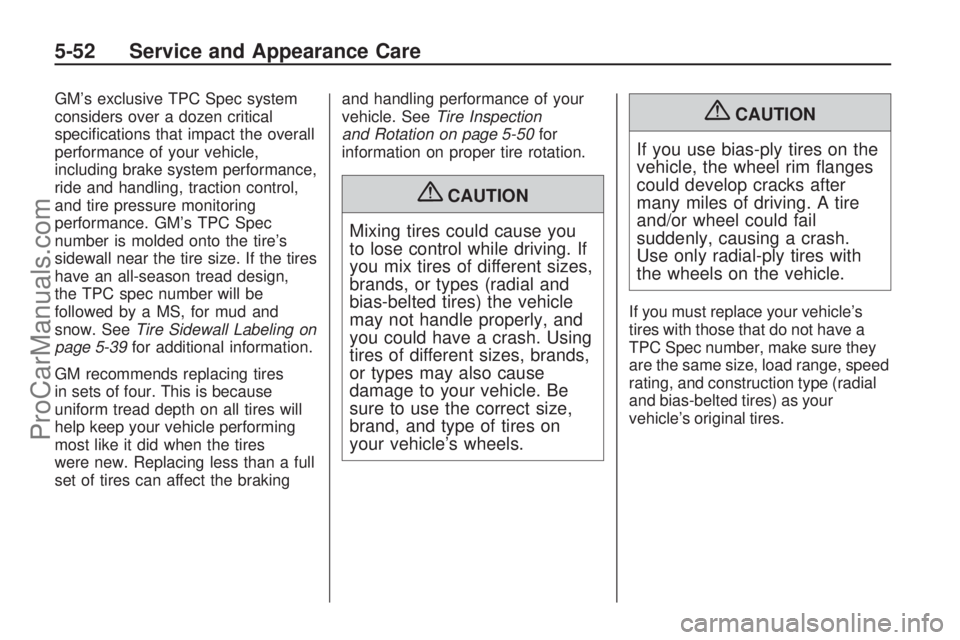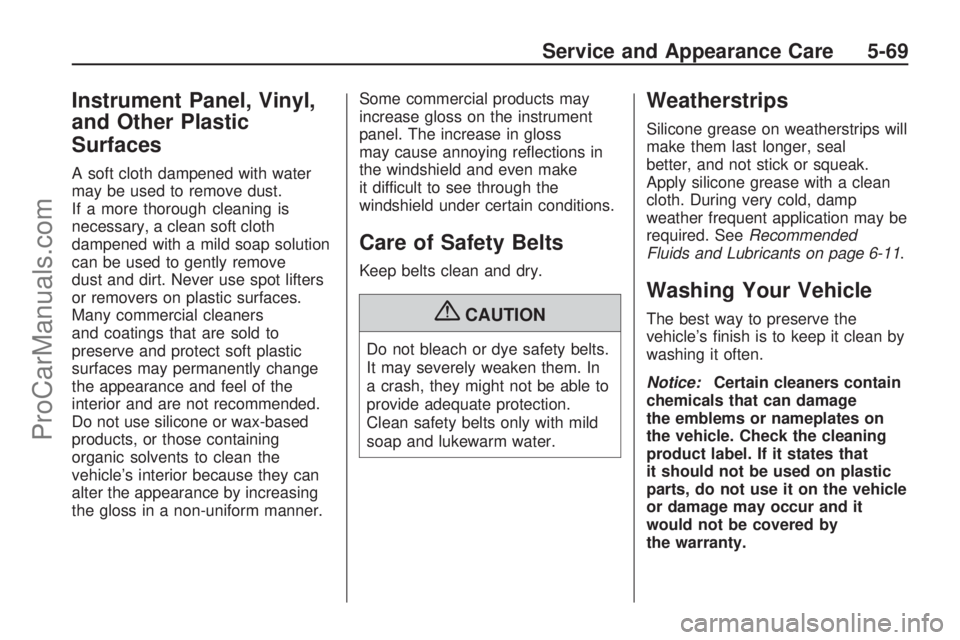belt SATURN VUE HYBRID 2009 Workshop Manual
[x] Cancel search | Manufacturer: SATURN, Model Year: 2009, Model line: VUE HYBRID, Model: SATURN VUE HYBRID 2009Pages: 346, PDF Size: 2.1 MB
Page 189 of 346

Driving for Better Fuel
Economy
Driving habits can affect fuel
mileage. Here are some driving tips
to get the best fuel economy
possible.
Avoid fast starts and accelerate
smoothly.
Brake gradually and avoid
abrupt stops.
Avoid idling the engine for long
periods of time.
When road and weather
conditions are appropriate, use
cruise control, if equipped.
Always follow posted speed limits
or drive more slowly when
conditions require.
Keep vehicle tires properly
in�ated.
Combine several trips into a
single trip.
Replace the vehicle’s tires with
the same TPC Spec number
molded into the tire’s sidewall
near the size.
Follow recommended scheduled
maintenance.
Defensive Driving
Defensive driving means “always
expect the unexpected.” The
�rst step in driving defensively is to
wear your safety belt — See
Safety Belts: They Are for Everyone
on page 1-10.
{CAUTION
Assume that other road users
(pedestrians, bicyclists, and other
drivers) are going to be careless
and make mistakes. Anticipate
what they might do and be ready.
In addition:
Allow enough following
distance between you and
the driver in front of you.
Focus on the task of driving.
Driver distraction can cause
collisions resulting in injury or
possible death. These simple
defensive driving techniques could
save your life.
Driving Your Vehicle 4-3
ProCarManuals.com
Page 196 of 346

Try to adjust the speed so you can
drive through the curve. Maintain
a reasonable, steady speed. Wait to
accelerate until out of the curve,
and then accelerate gently into the
straightaway.
Steering in Emergencies
There are times when steering can
be more effective than braking. For
example, you come over a hill and
�nd a truck stopped in your lane, or a
car suddenly pulls out from nowhere,
or a child darts out from between
parked cars and stops right in front of
you. These problems can be avoided
by braking — if you can stop in time.
But sometimes you cannot stop in
time because there is no room.
That is the time for evasive
action — steering around the
problem.
The vehicle can perform very well
in emergencies like these. First apply
the brakes. SeeBraking on
page 4-5. It is better to remove
as much speed as possible from acollision. Then steer around the
problem, to the left or right
depending on the space available.
An emergency like this requires
close attention and a quick decision.
If holding the steering wheel at
the recommended 9 and 3 o’clock
positions, it can be turned a full
180 degrees very quickly without
removing either hand. But you have
to act fast, steer quickly, and just
as quickly straighten the wheel once
you have avoided the object.The fact that such emergency
situations are always possible is a
good reason to practice defensive
driving at all times and wear
safety belts properly.
Off-Road Recovery
The vehicle’s right wheels can drop
off the edge of a road onto the
shoulder while driving.
If the level of the shoulder is only
slightly below the pavement,
recovery should be fairly easy.
4-10 Driving Your Vehicle
ProCarManuals.com
Page 219 of 346

Parking on Hills
{CAUTION
Parking the vehicle on a hill with
the trailer attached can be
dangerous. If something goes
wrong, the rig could start to move.
People can be injured, and both
the vehicle and the trailer can be
damaged. When possible, always
park the rig on a �at surface.
If parking the rig on a hill:
1. Press the brake pedal, but do
not shift into P (Park) yet.
Turn the wheels into the curb if
facing downhill or into traffic
if facing uphill.
2. Have someone place chocks
under the trailer wheels.3. When the wheel chocks are in
place, release the regular
brakes until the chocks absorb
the load.
4. Reapply the brake pedal. Then
apply the parking brake and
shift into P (Park).
5. Release the brake pedal.
Leaving After Parking on
a Hill
1. Apply and hold the brake pedal
while you:
Start the engine
Shift into a gear
Release the parking brake
2. Let up on the brake pedal.
3. Drive slowly until the trailer is
clear of the chocks.
4. Stop and have someone pick up
and store the chocks.
Maintenance When Trailer
Towing
The vehicle needs service more
often when pulling a trailer.
SeeScheduled Maintenance on
page 6-3for more information.
Things that are especially important
in trailer operation are automatic
transmission �uid, engine oil,
axle lubricant, belts, cooling system
and brake system. It is a good
idea to inspect these before and
during the trip.
Check periodically to see that all
hitch nuts and bolts are tight.
Engine Cooling When Trailer
Towing
The cooling system may temporarily
overheat during severe operating
conditions. SeeEngine Overheating
on page 5-23.
Driving Your Vehicle 4-33
ProCarManuals.com
Page 222 of 346

Tires
Tires.................................5-38
Tire Sidewall Labeling.......5-39
Tire Terminology and
De�nitions.......................5-41
In�ation - Tire Pressure. . . .5-43
Tire Pressure Monitor
System............................5-45
Tire Pressure Monitor
Operation........................5-46
Tire Inspection and
Rotation..........................5-50
When It Is Time for
New Tires.......................5-51
Buying New Tires.............5-51
Different Size Tires and
Wheels............................5-53
Uniform Tire Quality
Grading...........................5-54
Wheel Alignment and
Tire Balance....................5-55
Wheel Replacement..........5-55
Tire Chains.......................5-57
If a Tire Goes Flat............5-58
Tire Sealant and
Compressor Kit...............5-59
Tire Sealant and
Compressor Kit
Storage
...........................5-66
Appearance Care
Interior Cleaning................5-66
Fabric/Carpet....................5-68
Leather.............................5-68
Instrument Panel, Vinyl,
and Other Plastic
Surfaces
..........................5-69
Care of Safety Belts.........5-69
Weatherstrips....................5-69
Washing Your Vehicle.......5-69
Cleaning Exterior
Lamps/Lenses.................5-70
Finish Care.......................5-70
Windshield and Wiper
Blades.............................5-71
Aluminum Wheels.............5-72
Tires.................................5-72
Sheet Metal Damage........5-73
Finish Damage..................5-73
Underbody Maintenance. . . .5-73
Chemical Paint Spotting. . . .5-73
Vehicle Identi�cation
Vehicle Identi�cation
Number (VIN)..................5-74
Service Parts
Identi�cation Label...........5-74
Electrical System
Intermediate Voltage
Devices and Wiring.........5-74
Add-On Electrical
Equipment.......................5-75
Windshield Wiper Fuses. . . .5-75
Power Windows and
Other Power Options.......5-75
Fuses and Circuit
Breakers.........................5-75
Instrument Panel Fuse
Block...............................5-76
Underhood Fuse Block......5-77
Capacities and
Speci�cations
Capacities and
Speci�cations..................5-81
5-2 Service and Appearance Care
ProCarManuals.com
Page 224 of 346

California Perchlorate
Materials Requirements
Certain types of automotive
applications, such as airbag
initiators, seat belt pretensioners,
and lithium batteries contained in
remote keyless transmitters,
may contain perchlorate materials.
Special handling may be necessary.
For additional information, see
www.dtsc.ca.gov/hazardouswaste/
perchlorate.
Doing Your Own
Service Work
{CAUTION
Never try to do your own service
on hybrid components. You can
be injured and the vehicle can be
damaged if you try to do your own
service work. Service and repair
of these hybrid components
should only be performed by a
trained service technician with the
proper knowledge and tools.
{CAUTION
You can be injured and the
vehicle could be damaged if you
try to do service work on a vehicle
without knowing enough about it.
Be sure you have sufficient
knowledge, experience, the
proper replacement parts, and
tools before attempting any
vehicle maintenance task.
Be sure to use the proper
nuts, bolts, and other
fasteners. English and
metric fasteners can be
easily confused. If the wrong
fasteners are used, parts can
later break or fall off. You
could be hurt.
If doing some of your own service
work, use the proper service manual.
It tells you much more about how to
service the vehicle than this manual
can. To order the proper service
manual, seeService Publications
Ordering Information on page 7-13.This vehicle has an airbag system.
Before attempting to do your
own service work, seeServicing
Your Airbag-Equipped Vehicle
on page 1-54.
Keep a record with all parts receipts
and list the mileage and the date
of any service work performed. See
Maintenance Record on page 6-14.
Adding Equipment to
the Outside of the
Vehicle
Things added to the outside of the
vehicle can affect the air�ow
around it. This can cause wind
noise and can affect fuel economy
and windshield washer performance.
Check with your dealer/retailer
before adding equipment to
the outside of the vehicle.
5-4 Service and Appearance Care
ProCarManuals.com
Page 260 of 346

The TIN is molded onto both
sides of the tire, although
only one side may have the date
of manufacture.
(E) Tire Ply Material
:The type
of cord and number of plies
in the sidewall and under
the tread.
(F) Uniform Tire Quality
Grading (UTQG)
:Tire
manufacturers are required to
grade tires based on three
performance factors: treadwear,
traction and temperature
resistance. For more information
seeUniform Tire Quality
Grading on page 5-54.
(G) Maximum Cold In�ation
Load Limit
:Maximum load that
can be carried and the
maximum pressure needed to
support that load.Tire Size
The following illustration
shows an example of a typical
passenger (p-metric) vehicle
tire size.
(A) Passenger (P-Metric)
Tire
:The United States version
of a metric tire sizing system. The
letter P as the �rst character in
the tire size means a passenger
vehicle tire engineered to
standards set by the U. S. Tire
and Rim Association.
(B) Tire Width
:The three-digit
number indicates the tire
section width in millimeters from
sidewall to sidewall.
(C) Aspect Ratio
:A two-digit
number that indicates the tire
height-to-width measurements.For example, if the tire size
aspect ratio is 60, as shown in
item C of the illustration, it would
mean that the tire’s sidewall is
60 percent as high as it is wide.
(D) Construction Code
:A letter
code is used to indicate the type
of ply construction in the tire.
The letter R means radial ply
construction; the letter D means
diagonal or bias ply construction;
and the letter B means
belted-bias ply construction.
(E) Rim Diameter
:Diameter of
the wheel in inches.
(F) Service Description
:These
characters represent the load
range and speed rating of the
tire. The load index represents
the load carry capacity a tire is
certi�ed to carry. The load index
can range from 1 to 279. The
speed rating is the maximum
speed a tire is certi�ed to carry
a load. Speed ratings range
fromAtoZ.
5-40 Service and Appearance Care
ProCarManuals.com
Page 261 of 346

Tire Terminology and
De�nitions
Air Pressure:The amount of
air inside the tire pressing
outward on each square inch of
the tire. Air pressure is
expressed in pounds per square
inch (psi) or kilopascal (kPa).
Accessory Weight
:This means
the combined weight of
optional accessories. Some
examples of optional
accessories are, automatic
transmission, power steering,
power brakes, power windows,
power seats, and air
conditioning.
Aspect Ratio
:The relationship
of a tire’s height to its width.
Belt
:A rubber coated layer of
cords that is located between the
plies and the tread. Cords
may be made from steel or other
reinforcing materials.Bead
:The tire bead contains
steel wires wrapped by steel
cords that hold the tire onto
the rim.
Bias Ply Tire
:A pneumatic tire
in which the plies are laid at
alternate angles less than
90 degrees to the centerline of
the tread.
Cold Tire Pressure
:The
amount of air pressure in a tire,
measured in pounds per
square inch (psi) or kilopascals
(kPa) before a tire has built
up heat from driving. See
Inflation - Tire Pressure on
page 5-43.
Curb Weight
:The weight of a
motor vehicle with standard
and optional equipment including
the maximum capacity of fuel,
oil, and coolant, but without
passengers and cargo.DOT Markings
:A code molded
into the sidewall of a tire
signifying that the tire is in
compliance with the U.S.
Department of Transportation
(DOT) motor vehicle safety
standards. The DOT code
includes the Tire Identi�cation
Number (TIN), an alphanumeric
designator which can also
identify the tire manufacturer,
production plant, brand, and date
of production.
GVWR
:Gross Vehicle Weight
Rating. SeeLoading the Vehicle
on page 4-18.
GAWR FRT
:Gross Axle Weight
Rating for the front axle. See
Loading the Vehicle on
page 4-18.
GAWR RR
:Gross Axle Weight
Rating for the rear axle. See
Loading the Vehicle on
page 4-18.
Service and Appearance Care 5-41
ProCarManuals.com
Page 272 of 346

GM’s exclusive TPC Spec system
considers over a dozen critical
speci�cations that impact the overall
performance of your vehicle,
including brake system performance,
ride and handling, traction control,
and tire pressure monitoring
performance. GM’s TPC Spec
number is molded onto the tire’s
sidewall near the tire size. If the tires
have an all-season tread design,
the TPC spec number will be
followed by a MS, for mud and
snow. SeeTire Sidewall Labeling on
page 5-39for additional information.
GM recommends replacing tires
in sets of four. This is because
uniform tread depth on all tires will
help keep your vehicle performing
most like it did when the tires
were new. Replacing less than a full
set of tires can affect the brakingand handling performance of your
vehicle. SeeTire Inspection
and Rotation on page 5-50for
information on proper tire rotation.
{CAUTION
Mixing tires could cause you
to lose control while driving. If
you mix tires of different sizes,
brands, or types (radial and
bias-belted tires) the vehicle
may not handle properly, and
you could have a crash. Using
tires of different sizes, brands,
or types may also cause
damage to your vehicle. Be
sure to use the correct size,
brand, and type of tires on
your vehicle’s wheels.
{CAUTION
If you use bias-ply tires on the
vehicle, the wheel rim �anges
could develop cracks after
many miles of driving. A tire
and/or wheel could fail
suddenly, causing a crash.
Use only radial-ply tires with
the wheels on the vehicle.
If you must replace your vehicle’s
tires with those that do not have a
TPC Spec number, make sure they
are the same size, load range, speed
rating, and construction type (radial
and bias-belted tires) as your
vehicle’s original tires.
5-52 Service and Appearance Care
ProCarManuals.com
Page 289 of 346

Instrument Panel, Vinyl,
and Other Plastic
Surfaces
A soft cloth dampened with water
may be used to remove dust.
If a more thorough cleaning is
necessary, a clean soft cloth
dampened with a mild soap solution
can be used to gently remove
dust and dirt. Never use spot lifters
or removers on plastic surfaces.
Many commercial cleaners
and coatings that are sold to
preserve and protect soft plastic
surfaces may permanently change
the appearance and feel of the
interior and are not recommended.
Do not use silicone or wax-based
products, or those containing
organic solvents to clean the
vehicle’s interior because they can
alter the appearance by increasing
the gloss in a non-uniform manner.Some commercial products may
increase gloss on the instrument
panel. The increase in gloss
may cause annoying re�ections in
the windshield and even make
it difficult to see through the
windshield under certain conditions.
Care of Safety Belts
Keep belts clean and dry.
{CAUTION
Do not bleach or dye safety belts.
It may severely weaken them. In
a crash, they might not be able to
provide adequate protection.
Clean safety belts only with mild
soap and lukewarm water.
Weatherstrips
Silicone grease on weatherstrips will
make them last longer, seal
better, and not stick or squeak.
Apply silicone grease with a clean
cloth. During very cold, damp
weather frequent application may be
required. SeeRecommended
Fluids and Lubricants on page 6-11.
Washing Your Vehicle
The best way to preserve the
vehicle’s �nish is to keep it clean by
washing it often.
Notice:Certain cleaners contain
chemicals that can damage
the emblems or nameplates on
the vehicle. Check the cleaning
product label. If it states that
it should not be used on plastic
parts, do not use it on the vehicle
or damage may occur and it
would not be covered by
the warranty.
Service and Appearance Care 5-69
ProCarManuals.com
Page 303 of 346

Maintenance
Schedule
Maintenance Schedule
Introduction.........................6-1
Maintenance
Requirements....................6-1
Your Vehicle and the
Environment......................6-2
Using the Maintenance
Schedule...........................6-2
Scheduled Maintenance......6-3
Additional Required
Services............................6-5
Maintenance Footnotes.......6-7
Owner Checks and
Services............................6-8
At Each Fuel Fill................6-8
At Least Once a Month......6-9
At Least Once a Year........6-9
Recommended Fluids
and Lubricants................6-11
Maintenance
Replacement Parts..........6-12
Engine Drive Belt
Routing...........................6-13
Maintenance Record.........6-14
Maintenance
Schedule
Introduction
Important: Keep engine oil at the
proper level and change as
recommended.
Maintenance
Requirements
Notice:Maintenance intervals,
checks, inspections, replacement
parts, and recommended �uids
and lubricants as prescribed
in this manual are necessary to
keep this vehicle in good working
condition. Any damage caused
by failure to follow scheduled
maintenance might not be
covered by the vehicle warranty.
Maintenance Schedule 6-1
ProCarManuals.com